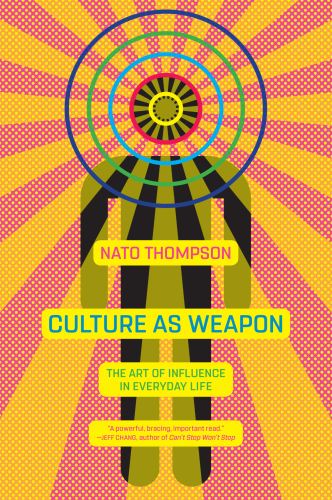
Culture as Weapon
The Art of Influence in Everyday Life
کتاب های مرتبط
- اطلاعات
- نقد و بررسی
- دیدگاه کاربران
نقد و بررسی

November 28, 2016
The latest from art critic Thompson (Seeing Power: Art and Activism in the 21st Century) chronicles the ever-increasing complexity and ubiquity of ads and artworks that manipulate people into purchasing an item or accepting an ideology. Beginning with an anecdote-heavy history of the golden age of advertising, Thompson reveals that companies increasingly stopped trying to market a product and turned toward marketing a social experience, a trend exemplified by Apple, Ikea, and Starbucks. Thompson compellingly suggests that selling a product and selling an ideology have historically applied disconcertingly similar tactics; indeed, the advertising firm behind the wildly successful Volkswagen Beetle ad campaign of the late 1950s later produced the famous “Daisy” campaign ad for Lyndon Johnson in 1964. Thompson’s approach emphatically hews to the left, recalling the politics of Howard Zinn and Naomi Klein, and he treats the term “culture” very broadly. The book is an energetic, briskly paced, and well-researched polemic that avoids cliché and succeeds in raising awareness of the cultural forces that shape brand preferences and political allegiance.

November 15, 2016
How persuasive cultural mechanisms are encoded in broader social structures, from high art to war-planning.Thompson (Seeing Power: Art and Activism in the Twenty-first Century, 2015, etc.) confidently casts a wide net in his discussion, seeing hidden hands of artifice and marketing that have long manipulated the citizenry. "I want to explain the ways in which those in power have to use culture to maintain and expand their influence," he writes, "and the role that we all play in that process." The author supports this ominous claim with a historical timeline and various categories of real-world occurrences, first focusing on the early "persuaders" of advertising and public relations and then looking at diverse examples, from lifestyle corporations like Apple and IKEA to the Pentagon's counterinsurgency theorists. Thompson first argues that the 1980s "culture wars" over art and funding provide a lens for understanding cultural manipulation within politics: "A number of forces were learning to utilize the power of culture to push forward their own agendas." He then looks further back to 1914, arguing that the Ludlow massacre of striking miners led John D. Rockefeller to develop innovations in public opinion-shaping that became widespread during World War I. During the 1920s, wartime propaganda morphed into the modern advertising and polling industries, embodied by George Gallup, who founded the American Institute of Public Opinion in 1935. As Thompson notes regarding Gallup's prescience, "if he could predict elections, what else could he do?" Yet simultaneously, artistic collectives and radical groups were recognizing the power of the same techniques, and the author explores topics from Dada and Andy Warhol to Saul Alinsky and the Black Lives Matter movement. Thompson characterizes our own time as deeply fearful, tying the racist politics of Lee Atwater's "Southern Strategy" to current controversies around mass imprisonment and police overreach. The author moves effortlessly between subtopics and tautly addresses particular oppressive social mechanisms, yet his focus on the pervasiveness of persuasion feels unsurprising.A precisely written critique of cultural manipulation in our daily lives.
COPYRIGHT(2016) Kirkus Reviews, ALL RIGHTS RESERVED.

December 1, 2016
In a sprawling and ambitious exploration, curator and critic Thompson (Seeing Power) outlines the ways that culture has been used and abused by governments, politicians, and corporations to manipulate behavior, earn money, and influence the outcome of armed conflict. Thompson's politics and passion for social activism are never far from the surface. He attempts to draw together diverse threads such as Nazi propaganda, the culture wars of the 1980s and 1990s, counterinsurgency doctrine in Iraq and Afghanistan, social justice initiatives in Philadelphia, the artwork of Andy Warhol, Breast Cancer Awareness Month, and the social engineering of retail spaces in order to show how those in power seek to manipulate and modify the behavior of consumers to maximize both political and economic gain. Thompson's writing shines when discussing the arts and the "charity industrial complex"; his forays into military analysis are less successful. VERDICT This dense and wide-ranging read will appeal to those interested in critiques of capitalism and the philosophical questions raised by the corporate manipulation of culture.--Rebecca Brody, Westfield State Univ., MA
Copyright 2016 Library Journal, LLC Used with permission.

December 1, 2016
Thompson, chief curator at the public-art organization Creative Time, author of Seeing Power: Art and Activism in the Age of Cultural Production (2015), and editor of several other books, here explores the intersections of art, culture, and manipulation in society. He offers compelling historical examples of how government, corporations, and individuals, including artists and activists, have utilized and harnessed the powers of art and culture to shift and influence perceptions and images in public dialogue. Thompson writes confidently that governments and big businesses have employed marketing techniques in order to influence consumers to drive up profits or support specific agendas. He describes the role of artists who have resisted and challenged the influences of various institutions through their creative and political activities. This is a swift read for those who enjoy cultural and social politics and the history of marketing and advertising in America. Readers will find Thompson's book to be informative, profound, and alarming, as he traces the ongoing developments of those who are manipulating culture and art through technology and social media today.(Reprinted with permission of Booklist, copyright 2016, American Library Association.)

























دیدگاه کاربران